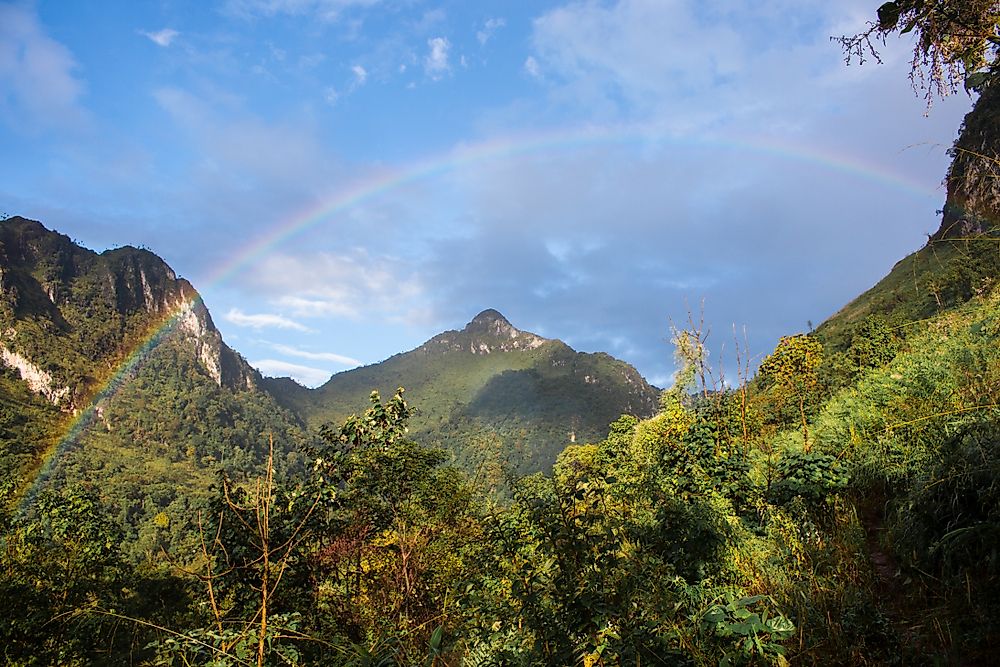How Are Rainbows Formed?

It is commonly understood that a rainbow appears when sunny skies and raindrops combine, but what exactly is it about this combination that creates such vibrant colors in the sky?
A rainbow forms as the result of the reflection and refraction of light. When sunlight enters a clear object, such as a prism or a raindrop, part of it is reflected while another part enters and is refracted. When sun hits a raindrop, its light is broken up into several difference colors. Rainbows are actually full circles - because we only see half of them, we process them as an arc.
3. Types of Rainbows
There are many, many, many types of rainbows that exist. Here is a quick list of each type:
- Rainbow: Colorful arc that appears when it rains but the sun is shining opposite the observer.
- Secondary bow: This bow usually appears outside the main bow, and is fainter after the light rays have escaped two whole reflections. In other words, the rainbow itself is being reflected in raindrops. The colors always appear in the opposite direction of a rainbow.
- Supernumeraries: Closely spaced additional greenish purple arcs found inside even the violet color of the primary rainbow. These are formed by rays having different path lengths within each droplet.
- Red Bow: Simply a rainbow seen at sunrise or sunset when light has to pass through the lower atmosphere, resulting in longer wavelengths of light.
- Rainbow Wheel: A rainbow combined with crepuscular (or in this case, anticrepuscular) rays that converge on a point on the horizon.
- Dew Bow: Fairly rare, these are created by dew drops on grass or in spider webs, and generally form a full halo. Dew bows are most commonly found in the autumn.
- Spray Bow: A rainbow formed by the spray of a wave, waterfall, or geyser, and often a smaller arc than a normal bow.
- Glass Bead Bows: These appear following the resurfacing of a road, and after that road dries. Because glass is more refractive, these bows are only half the size of rainbows.
- Twinned Bows: A rare phenomenon where two rainbows seem to cross during heavy rainfall. There is no clear explanation for these yet, but the best theory seems to be that when heavy raindrops are flattened some by air resistance, they elongate, possibly producing both bows.
- Cloud Bows: Also not very common, these bows are created without any actual rain, but instead small water droplets in the form of mist or damp air. .
2. Role In Religion And Mythology
Since the dawn of civilization, the rainbow has been central to the folklore of many cultures. The Norse knew rainbows as Bifrost, a bridge that connected Earth to Asgard, the home of the Norse gods, and could only be accessed by gods and warriors killed in battle. In Hinduism, Indra was the god of thunder who used the rainbow to shoot arrows of lightning. Iris was the personified goddess of the rainbow in Ancient Greece. In Australian Aboriginal myth, the Rainbow Serpent is the creator of the world and everything on it. It was believed that during the dry season the Rainbow Serpent would retreat into a distant waterhole before finally returning for the rain.
1. How Common Are Rainbows?
Seeing a rainbow is actually more rare than what is commonly led on. Even in a rainy place like England, there may be fewer than ten bright rainbows in a year. However, in locations that receive more rain, rainbows may be more common, since rainbows are merely caused by the reflection, refraction, and dispersion of light inside water droplets into the full spectrum of light in the sky, often set against the backdrop of darker storm clouds, which in turn highlights the rain droplets directing and scattering light and so shining bright inside the rainbow arc. Rainbows are always observed opposite the sun with no exception.











